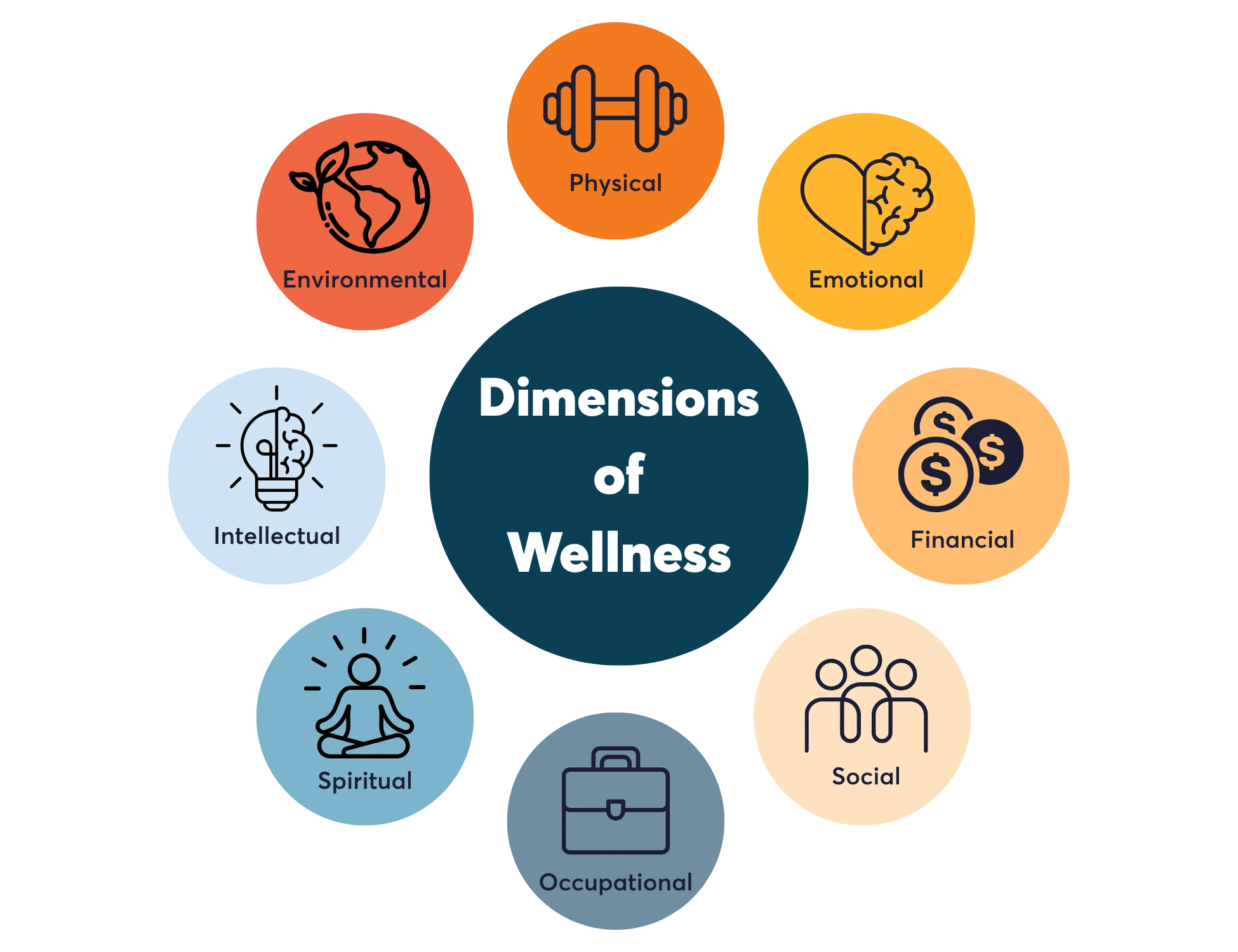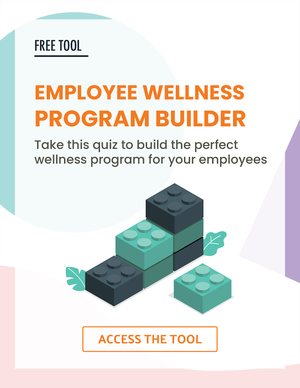What Is an Employee Wellness Program?
Employee wellness programs, also known as worksite wellness programs, corporate wellness programs, or employee well-being programs, refer to a collection of initiatives within an organization that promote healthy lifestyles among employees and, in some cases, their spouses and dependents. These programs address various dimensions of employee health and well-being, including nutrition, fitness, mental health, and more.
Employee Wellness Program Benefits
Employee wellness programs are strategic tools for building a thriving, people-first workplace. When thoughtfully implemented, these programs support employee well-being and organizational success. Benefits of employee wellness programs include:
- Enhanced employee satisfaction and engagement: Employees who feel supported in their well-being are more likely to be satisfied at work. Research shows that 89% of employees working for companies with wellness programs are engaged and happy with their jobs.
- Improved workplace culture: Organizations that prioritize employee health and well-being show a genuine commitment to their people. This fosters a culture of care, strengthens team morale, and builds trust in the employer.
- Decreased workplace stress: Employees are 73% less likely to feel burned out when their organization prioritizes their well-being. Comprehensive wellness programs that include initiatives like mental health resources and flexible schedules help relieve daily pressures and support better work-life balance.
- Improved employee health outcomes: Holistic wellness programs lead to healthier lifestyle choices and better health outcomes, including fewer chronic health issues and reduced absenteeism due to illness. In fact, employees who participate in wellness programs take 56% fewer sick days.
- Higher retention rates: Wellness programs increase loyalty and reduce turnover by showing employees that their health and happiness matter to the organization. Research indicates that when employees feel that their employer cares for their well-being, they are 53% less likely to seek out a new job.
- Increased productivity and performance: Healthy, engaged employees bring more energy, focus, and resilience to their work. When all aspects of their well-being are supported—from physical to emotional, financial, and social wellness—they are better equipped to consistently and sustainably perform at a high level without getting burned out.
Components of an Impactful Wellness Program
A thoughtfully designed wellness program consists of the following key components that drive success and long-term sustainability.
Holistic Approach
Wellness is often narrowly associated with gym memberships or green smoothies, limiting the scope to physical well-being. However, true well-being results from balancing multiple dimensions of wellness that, when nurtured in harmony, enhance a person’s health and quality of life.
Effective wellness programs address and promote the following dimensions of wellness:
- Physical: Maintaining a healthy body through exercise, nutrition, and sleep.
- Emotional: Managing feelings constructively, including coping with stress and building resilience.
- Financial: Handling finances effectively to reduce stress and increase security.
- Social: Building and maintaining healthy relationships, feeling connected to others, and having a sense of belonging and support.
- Occupational: Contributing to meaningful work, experiencing career growth, and achieving work-life balance.
- Spiritual: Pursuing one’s goals and living out values personally and professionally.
- Intellectual: Learning new skills, challenging the mind, and fostering curiosity.
- Environmental: Living in harmony with nature and taking action to protect the planet.

Leadership Support
When leaders participate in wellness initiatives, it sets the tone for the entire organization, encouraging wider engagement and fostering a culture of health and wellness at work. Strong leadership support can also help secure a program budget and promote cross-department collaboration to keep wellness programs thriving.
Effective leadership involvement includes:
- Wellness activity participation: Whether joining weekly walking groups, team fitness challenges, or mindfulness sessions alongside employees, leaders can regularly take part in wellness initiatives to demonstrate that well-being is a company priority.
- Event engagement: Leaders can encourage participation and engagement by highlighting the value of wellness initiatives for the company and employees. This might look like giving the opening remarks at a health fair, wellness challenge kickoff, or start of mental health awareness week.
- Personal testimonials: Personal stories from leaders—such as how practicing yoga helped them manage stress during a busy quarter—make wellness tangible and relatable. It also shows employees that wellness is for everyone, regardless of position or schedule.
Rewards and Incentives
Wellness program rewards and incentives foster immediate engagement and contribute to a lasting culture of health. While lifestyle change should be intrinsically motivated, incentives can help employees overcome the initial hurdle of getting started and kickstart healthier choices, paving the way for sustained well-being. To promote authentic engagement when using rewards and incentives, consider the following:
- Continuous reward programs: Keep the momentum going with a points-based program that recognizes progress and dedication over time, turning short-term wins into lasting habits.
- Lifestyle Spending Accounts: Offer flexible funds to support diverse wellness and lifestyle needs, streamline reimbursements, and motivate ongoing participation.
- Affordable incentives: Think beyond cash with affordable but meaningful incentives like extra paid time off, branded company merchandise, or public recognition for consistent participation.
- Peer-to-peer recognition: Empower employees to acknowledge and reward colleagues for healthy behaviors by using social recognition feeds or enabling peer-to-peer reward distribution.
Inclusivity
An inclusive wellness program accommodates the diverse needs of all employees, ensuring everyone can participate and benefit. Inclusivity in wellness means:
- Organizing varied wellness activities: Provide a wide range of options—such as high- and low-intensity fitness classes, mindfulness sessions, financial wellness workshops, and creative outlets—that appeal to different ability levels, interests, and lifestyles.
- Offering multiple participation formats: Make programs accessible with on-demand, on-site, and remote options so employees can engage in an environment that best suits their comfort level and schedule.
- Designing DEIB-friendly initiatives: Partner with diverse wellness providers, use inclusive imagery and language in promotions, and create activities that reflect and respect different cultural backgrounds and identities, such as a cultural cooking class or a globally-inspired fitness challenge.
Lifestyle-Based Programming
Unlike clinically focused wellness programs, which target specific health conditions, lifestyle-based programs emphasize daily habits that contribute to overall well-being. These initiatives address broader workforce needs and weave wellness into everyday life, making it easier for employees to sustain healthy behaviors and see long-term results.
Strategies for lifestyle-based wellness programs include:
- Offering a Personal Wellness Assessment (PWA): Provide employees with self-assessment tools that highlight strengths, risks, and areas for improvement across lifestyle behaviors such as nutrition, activity, sleep, and stress management. A PWA can guide employees toward personalized goals and appropriate resources.
- Prioritizing variety and customization: Offer a wide variety of wellness initiatives—like fitness challenges, mindfulness practices, or nutrition workshops—and allow employees to tailor their wellness journeys by selecting activities that align with their interests, schedules, and goals.
- Integrating wellness into the workday: Encourage habits that fit naturally into the flow of the workday to make wellness feel accessible and achievable. Examples include guided stretch breaks, walking meetings, healthy snack stations, or scheduled digital nudges that remind employees to pause, breathe, and reset.
Technology Integrations
Technology has become a cornerstone of modern wellness programs, enhancing accessibility and impact. When thoughtfully integrated, it helps employees engage more consistently, provides actionable insights, and enables organizations to measure outcomes with greater accuracy. Integrating technology into a wellness program can look like:
- Using a wellness platform: Leverage a digital hub that consolidates well-being resources, communications, challenges, and analytics in one place to streamline participation and track engagement more effectively.
- Integrating wearable devices: Encourage the use of wearables and mobile apps that monitor steps, physical activity, sleep, and general health metrics. Real-time feedback empowers employees to take ownership of their habits while fostering friendly competition through synced team challenges or leader boards.
- Ensuring compatibility between the platform and devices: Integrated data creates a more holistic view of employee well-being and reduces friction for employees and administrators.
Employee Feedback
Integrating employee feedback ensures wellness programs are relevant, meaningful, and effective. When employees feel their voices have a part in shaping the program, it fosters a sense of ownership, increasing participation and engagement. Tools for soliciting feedback include:
- Employee interest surveys: Conduct regular surveys to understand employees’ priorities, wellness interests, and perceived barriers to building healthy habits. These insights can guide program design, helping organizations offer activities and resources that resonate most with their workforce.
- Open feedback channels: Provide ongoing opportunities for employees to share input, such as digital suggestion boxes or anonymous forms that allow employees to surface ideas or challenges as they emerge.
- Focus groups or feedback meetings: Host small group discussions or town halls where employees can share experiences in real time. These forums generate actionable insights, foster community, and show leadership’s commitment to creating impactful programs.
Program Assessment
Determining the return on investment (ROI) of wellness programs is complex and overlooks benefits that may not yield immediate returns (e.g., improved employee morale, increased productivity). Value on investment (VOI) offers an alternative approach that assesses the broader impact of wellness programs beyond financial returns. It considers both quantitative and qualitative factors, including employee engagement, retention, and well-being.
By estimating both ROI and VOI, organizations can acknowledge the financial returns and intangible benefits of wellness programs, offering a more comprehensive view of their impact.

Use Wellable's ROI & VOI Calculator to measure both the financial returns and the hidden benefits of your wellness programs that impact your bottom line.
ACCESS NOW22 Employee Wellness Program Examples
To help employees improve their well-being, companies can employ various types of wellness programs and offerings depending on the unique needs of their organization.
Below are the top examples of wellness program initiatives, including benefits and key considerations for each to guide you in creating the program that best serves your organization and employees.
1. Wellness Challenges
Wellness challenges are a set of activities and contests designed to encourage employees to engage in healthy behaviors. They also support team building, improve engagement, and foster a sense of belonging at work. Wellness challenges can be designed to address a broad range of topics, including physical, mental, financial, social, and environmental well-being. With advancements in wearable devices and mobile apps, progress and engagement tracking is simpler and more accessible than ever.
| Benefits | Key Considerations |
|---|---|
|
|
2. Mental Health Resources
Providing access to mental health resources, such as counseling sessions, online mental health services, and workshops on mental well-being, can strengthen employees’ resilience and emotional stability. These resources help break down the stigma associated with mental health issues and ensure employees have the support they need to manage stress, anxiety, depression, and other mental health challenges.
| Benefits | Key Considerations |
|---|---|
|
|
3. Telemedicine
Telemedicine has grown rapidly over the last decade, offering a convenient and cost-effective way to access healthcare. By using electronic communications and secure software, employees can connect with providers without the need for in-person visits. Common uses include follow-up appointments, chronic condition management, medication refills, and specialist consultations, making care more flexible, efficient, and accessible for today’s workforce.
| Benefits | Key Considerations |
|---|---|
|
|
4. Fitness Classes
Fitness classes are a powerful way for organizations to promote employee health while fostering camaraderie and fun. Group exercise improves physical fitness and is also proven to significantly boost mental health, offering benefits across multiple dimensions of wellness. For businesses without suitable spaces, sponsoring fitness classes at third-party facilities or offering on-demand classes is an excellent alternative. Beyond traditional workouts, fitness classes can also include activities like guided meditation, offering an easy way to recharge and improve well-being.
| Benefits | Key Considerations |
|---|---|
|
|
5. Stress Management/Resilience
Stress management and resilience programs equip employees with tools to regulate emotions, cope with challenges, and buffer against future stressors. Effective approaches include hosting workshops on stress reduction techniques, providing access to digital meditation or mindfulness platforms, and offering on-demand resources that promote resilience and productivity.
| Benefits | Key Considerations |
|---|---|
|
|
6. Sleep Management
Sleep management programs highlight the importance of a good night’s snooze and provide employees with tools to improve sleep quality. These can include educational resources on sleep hygiene, rest-related challenges, discounts on sleep aids, and supportive workplace policies that promote healthy work-life boundaries. By helping employees recharge effectively, sleep programs reduce burnout and support sustained performance.
| Benefits | Key Considerations |
|---|---|
|
|
7. Tobacco Cessation
Global smoking rates have steadily declined over the last decade, but according to the World Health Organization, tobacco continues to be a major threat to public health, with 1.25 billion adult users around the world. Approximately two-thirds of adults who smoke want to quit, and over half have recently tried, but less than 10% have succeeded. A comprehensive tobacco cessation program provides employees with the tools, resources, and encouragement they need to successfully quit and improve long-term health outcomes.
| Benefits | Key Considerations |
|---|---|
|
|
8. Health Education and Literacy
Health education and literacy programs are often among the first wellness initiatives organizations implement due to their scalability and low cost. These programs provide employees with access to relevant, quality, and timely health content through on-site seminars or online webinars, as well as through other media such as newsletters or wellness brochures. With the growing amount of misinformation permeating the internet, employer-led education is becoming increasingly important. These educational sessions can address any dimension of wellness, ensuring relevance for a diverse workforce.
| Benefits | Key Considerations |
|---|---|
|
|
9. Lifestyle Spending Account (LSA)
A lifestyle spending account (LSA) is an employer-provided benefits account that supports diverse workforce needs through a flexible stipend. Employees receive a one-time or recurring allowance to spend on lifestyle and wellness-related products and services of their choice, such as gym memberships, childcare, pet care, leisure activities, travel, and more. The key benefit of an LSA is its flexibility, empowering employees to choose what matters most to them while giving organizations a scalable way to support holistic well-being.
| Benefits | Key Considerations |
|---|---|
|
|
10. Flu Shots
Flu shot clinics support employees' physical wellness while reducing absenteeism and healthcare costs associated with lost productivity and sick leave. Many organizations have added flu shot clinics to their wellness programs, typically as one-day events where nurses come to the workplace to administer vaccines.
| Benefits | Key Considerations |
|---|---|
|
|
11. Free Healthy Food
Free food has long been a favorite workplace perk, but traditional options like chips and candy aren’t the healthiest choices. To promote healthy eating, organizations are starting to stock their kitchen with more nutritious options, such as snacks with whole grains, healthy fats, and protein. Additionally, pairing free, healthy food with a nutrition challenge can support employees in making healthier food choices inside and outside of the office.
| Benefits | Key Considerations |
|---|---|
|
|
12. Gym Reimbursement
Reimbursing employees for the membership cost of exercise facilities can encourage them to work out without cutting into normal work hours (a common tradeoff of offering on-site fitness classes). This is an attractive benefit, especially for millennials and younger generations, who place high consideration on total rewards programs and benefits. Gym reimbursement is best suited for medium and large employers that can allocate the budget, but many health plans also include built-in fitness reimbursement options to help offset costs.
| Benefits | Key Considerations |
|---|---|
|
|
13. Mindfulness and Meditation Programs
Mindfulness and meditation programs help employees reduce stress, improve focus, and build resilience through initiatives like guided meditation sessions, mindfulness training workshops, or access to self-service mindfulness apps. Particularly beneficial in high-stress industries, these programs are scalable and accessible for companies of all sizes, including remote and global teams. Incorporating these practices into wellness offerings can help create a more mindful workplace environment, improving employee well-being and productivity.
| Benefits | Key Considerations |
|---|---|
|
|
14. Financial Counseling and Planning
In a recent study, 70% of U.S. adults reported that their financial stress is at an all-time high. As the cost of living continues to rise, financial wellness programs are rapidly gaining popularity. Many organizations bring in financial professionals to provide employees with personalized counseling or financial planning. These sessions give employees tools to manage debt, budget effectively, and plan for the future, and may be offered one-on-one or in a group format.
| Benefits | Key Considerations |
|---|---|
|
|
15. Health Coaching
Health coaching provides employees with personalized educational sessions led by certified health expert that can be conducted in either one-on-one or group formats. Some companies position health coaching as a next step for employees identified as high-risk through a biometric screening or health risk assessment, while others extend the benefit to anybody seeking support in their health journey. Because health coaching sessions are personalized, they can address various health or wellness concerns, from managing chronic conditions to building healthier lifestyle habits.
| Benefits | Key Considerations |
|---|---|
|
|
16. Health Fairs
Health fairs are educational and interactive events that provide employees with valuable health education and resources in an engaging format. On-site fairs are typically scheduled during the workday, allowing employees to visit booths, attend mini-sessions, and learn about well-being topics or how to better navigate their benefits. For companies with remote or hybrid teams, virtual health fairs are an accessible and cost-effective alternative. By bringing together vendors, providers, and resources in one place, health fairs empower employees to make informed choices about their health, benefits, and well-being.
| Benefits | Key Considerations |
|---|---|
|
|
17. On-Site or Near-Site Clinics
On-site and near-site clinics provide employees with convenient access to health care directly at or near their workplace. Staffed with clinicians who are familiar with the organization’s policies, benefit plans, and work environment, these clinics can resolve most routine medical needs without requiring outside referrals. This convenience saves employees time and can also lower healthcare costs for employees and the organization by reducing unnecessary external visits.
| Benefits | Key Considerations |
|---|---|
|
|
18. Disease Management
Disease management programs are structured treatment plans that aim to help people better manage chronic disease(s) and maintain and improve quality of life. A team of health professionals, including physicians, nurses, pharmacists, dietitians, and more, are involved to educate participants on an ongoing basis about how to better manage their conditions. Some programs might be more patient-directed and include counseling, home visits, 24-hour call centers, and appointment reminder systems to support individuals who are managing their chronic condition(s).
| Benefits | Key Considerations |
|---|---|
|
|
19. Annual Physical
Physician engagement programs encourage employees to complete annual physical exams with their primary care providers. These programs may include incentives for completing annual check-ups or involve implementing streamlined channels for booking appointments. While research shows that annual physicals may have limited impact on young, healthy adults, they remain valuable for early detection of health issues, building long-term physician-patient relationships, and supporting proactive health management across the workforce.
| Benefits | Key Considerations |
|---|---|
|
|
20. Weight Management
Weight management programs aim to help employees achieve and maintain a healthy weight through a mix of digital and in-person interventions, typically focused on exercise and nutrition. While these initiatives have had a steady presence in many wellness programs, evidence of their effectiveness is limited. Employers may find greater impact by investing in broader wellness strategies such as health literacy, nutrition programs, and fitness initiatives that encourage sustainable lifestyle changes.
| Benefits | Key Considerations |
|---|---|
|
|
21. Biometric Screening
A historic staple of wellness programs, biometric screenings involve measuring employees' physical characteristics, such as body mass index (BMI), blood pressure, cholesterol, glucose level, and more. These screenings are often used for early detection of health risks and to increase awareness of potential conditions and treatment options. While some studies suggest benefits, the research on long-term health outcomes remains mixed, and certain professional medical organizations note that routine screenings may not be necessary for healthy, asymptomatic adults.
| Benefits | Key Considerations |
|---|---|
|
|
22. Health Risk Assessment (HRA)
Also known as a health risk appraisal, an HRA is a questionnaire used to collect information on employees’ health status, risks, and habits. Often paired with biometric screenings, HRAs are designed to give employers and employees insights into potential risk factors. However, because data is self-reported, HRAs are prone to bias and inaccuracies, and there is little evidence they improve employee health or reduce costs.
| Benefits | Key Considerations |
|---|---|
|
|
A Personal Wellness Assessment (PWA) is an alternative to the traditional HRA that offers a more engaging, holistic way to assess employees’ well-being. Instead of narrowly focusing on risks, a PWA invites employees to take a comprehensive look at their health, covering lifestyle factors like nutrition, physical activity, sleep, stress management, finances, and resilience. By highlighting strengths and growth areas, a PWA empowers employees with personalized insights and actionable next steps, guiding them toward the resources and habits that best support their individual goals.
Frequently Asked Questions
An employee wellness program is a set of organizational initiatives aimed at promoting employee health and well-being. A comprehensive program takes a holistic approach, addressing multiple dimensions of wellness, such as physical, emotional, financial, social, and occupational well-being.
Employee wellness programs offer numerous benefits, including increased employee satisfaction and engagement, enhanced workplace culture and morale, decreased burnout and stress, higher retention, lower turnover, and boosted organizational performance.
An effective wellness program takes a holistic approach, addressing multiple dimensions of well-being such as physical, emotional, and financial health. It requires leadership support, inclusive activities, and incentives that motivate participation and foster a culture of well-being. The integration of technology, lifestyle-based habits, and ongoing employee feedback ensures the program remains engaging, accessible, and impactful.
Organizations can choose from a wide variety of wellness initiatives depending on their goals and employee needs. Popular options include wellness challenges, mental health resources, fitness classes, gym reimbursements, financial counseling, lifestyle spending accounts, and more.



